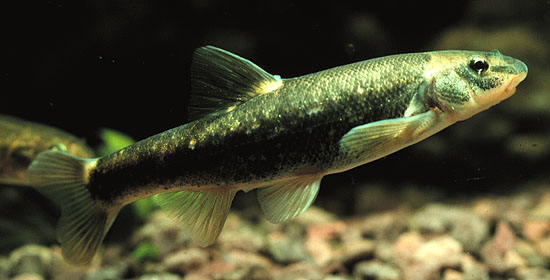Fish Iowa - Fish Species - Longnose dace

Characteristics
Olive-green to brown on the back and upper sides shading to white on the belly. Darkened scale pockets give the sides a mottled look, and the lateral band is indistinct in adults. Breeding males are washed with pink on the lower parts of the body. There are 61 to 73 scales in the complete lateral line. Hooked pharyngeal teeth are arranged in a 2, 4-4, 2 pattern, but this formula may vary. The upper jaw and snout greatly overhangs the lower jaw, and a barbel is present at the tip of the maxillary. A silver peritoneum speckled with brown covers the gut cavity, and the air bladder is simple. Dorsal and pelvic fins have 8 rays, while the anal fin has 7 rays, and the pectoral fins have from 13 to 15 rays.
Foods
- No results found
Expert Tip
- No results found
Details
The Longnose Dace spawns over clean sand or gravel in swift current in April and May. Adults are 4- to 5-inches long at maturity and live in riffles of gravel and boulder.
Recent stream sampling information is available from Iowa DNR's biological monitoring and assessment program.
Distribution Map

Confined to the extreme northeast corner of Iowa. Collections have been recorded in the Upper Iowa, Yellow, Turkey, Volga, and the upper reaches of the Maquoketa Rivers, where they are common in nearly all samples.
See our most recent distribution data for this species on the Iowa DNR's Bionet application.
State Record(s)
Master Angler Catches
No Master Angler catches currently exist for this species.
Submit your Master Angler catchFish Surveys
Tip: Click Species Length by Site, then use the dropdown to filter by fish species of interest.Where this Fish Is Found
Bankston Creek
Bigalk Creek
Bloody Run Creek
Bohemian Creek
Buck Creek
Clear Creek (Lansing)
Coldwater Creek
Coon Creek
Fountain Springs
Hewett and Ensign Creeks (Ensign Hollow)
Joy Springs
Little Turkey River
Maquoketa River (trout portion)
Mossy Glen
North Cedar Creek
Otter Creek
Paint Creek
Pine Creek
Sny Magill Creek
Spring Falls
Swiss Valley Creek
Trout Run
Upper Swiss Valley Creek
Yellow River (Trout Section)